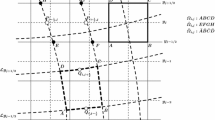Abstract
The dispersal and mixing of scalar quantities such as concentrations or thermal energy are often modeled by advection-diffusion equations. Such problems arise in a wide variety of engineering, ecological and geophysical applications. In these situations a quantity such as chemical or pollutant concentration or temperature variation diffuses while being transported by the governing flow. In the passive scalar case, this flow prescribed and unaffected by the scalar. Both steady laminar and complex (chaotic, turbulent or random) time-dependent flows are of interest and such systems naturally lead to questions about the effectiveness of the stirring to disperse and mix the scalar. The development of reliable numerical methods for advection-diffusion equations is crucial for understanding their properties, both physical and mathematical. In this paper, we extend a fast explicit operator splitting method, recently proposed in (A. Chertock, A. Kurganov, G. Petrova, Int. J. Numer. Methods Fluids 59:309–332, 2009), for solving deterministic convection-diffusion equations, to the problems with random velocity fields and singular source terms. A superb performance of the method is demonstrated on several two-dimensional examples.
Similar content being viewed by others
References
Chertock, A., Kashdan, E., Kurganov, A.: In: Benzoni-Gavage, S., Serre, D. (eds.) Propagation of Diffusing Pollutant by a Hybrid Eulerian-Lagrangian Method. Hyperbolic Problems: Theory, Numerics, Applications, Lyon, 2006, pp. 371–380. Springer, Berlin (2008)
Chertock, A., Kurganov, A.: On splitting-based numerical methods for convection-diffusion equations. In: Puppo, G., Russo, G. (eds.) Numerical Methods for Balance Laws, Aracne editrice S.r.l., Rome (2010)
Chertock, A., Kurganov, A., Petrova, G.: Fast explicit operator splitting method. Application to the polymer system. In: Benkhaldoun, F., Ouazar, D., Raghay, S. (eds.) Finite Volumes for Complex Applications, vol. IV, pp. 63–72. Hermes Science Publishing, London (2005)
Chertock, A., Kurganov, A., Petrova, G.: Fast explicit operator splitting method for convection-diffusion equations. Int. J. Numer. Meth. Fluids 59, 309–332 (2009)
Cockburn, B., Johnson, C., Shu, C.-W., Tadmor, E.: Advanced numerical approximation of nonlinear hyperbolic equations. In: Quarteroni, A. (ed.) CIME Lecture Notes. Lecture Notes in Mathematics, vol. 1697. Springer, Berlin (1997)
Doering, C.R., Thiffeault, J.-L.: Multiscale mixing efficiencies for steady sources. Phys. Rev. E 74, 025301(R) (2006)
Drummond, I.T.: Path-integral methods for turbulent diffusion. J. Fluid Mech. 123, 59–68 (1982)
Godlewski, E., Raviart, P.-A.: Numerical Approximation of Hyperbolic Systems of Conservation Laws. Applied Mathematical Sciences, vol. 118. Springer, New York (1996)
Gottlieb, S., Shu, C.-W., Tadmor, E.: Strong stability-preserving high-order time discretization methods. SIAM Rev. 43, 89–112 (2001)
Hundsdorfer, W., Verwer, J.: Numerical Solution of Time-dependent Advection-Diffusion-Reaction Equations. Springer Series in Computational Mathematics, vol. 33. Springer, Berlin (2003)
Kröner, D.: Numerical Schemes for Conservation Laws. Wiley-Teubner Series Advances in Numerical Mathematics. John Wiley & Sons Ltd., Chichester (1997)
Kurganov, A., Lin, C.-T.: On the reduction of numerical dissipation in central-upwind schemes. Commun. Comput. Phys. 2, 141–163 (2007)
Kurganov, A., Noelle, S., Petrova, G.: Semi-discrete central-upwind scheme for hyperbolic conservation laws and Hamilton-Jacobi equations. SIAM J. Sci. Comput. 23, 707–740 (2001)
Kurganov, A., Tadmor, E.: New high resolution central schemes for nonlinear conservation laws and convection-diffusion equations. J. Comput. Phys. 160, 241–282 (2000)
Kurganov, A., Tadmor, E.: Solution of two-dimensional Riemann problems for gas dynamics without Riemann problem solvers. Numer. Methods Partial Differ. Equ. 18, 584–608 (2002)
Lee, J., Fornberg, B.: A split step approach for the 3-D Maxwell’s equations. J. Comput. Appl. Math. 158(2), 485–505 (2003)
LeVeque, R.J.: Finite Volume Methods for Hyperbolic Problems. Cambridge Texts in Applied Mathematics. Cambridge University Press, Cambridge (2002)
Lie, K.-A., Noelle, S.: On the artificial compression method for second-order nonoscillatory central difference schemes for systems of conservation laws. SIAM J. Sci. Comput. 24(4), 1157–1174 (2003)
Majda, A.J., Kramer, P.R.: Simplified models for turbulent diffusion: theory, numerical modelling, and physical phenomena. Phys. Rep. 314(4–5), 237–574 (1999)
Marchuk, G.I.: Metody Rasshchepleniya (Russian) [Splitting Methods] Nauka, Moscow (1988)
Marchuk, G.I.: Splitting and alternating direction methods. In: Handbook of Numerical Analysis, vol. I, pp. 197–462. North-Holland, Amsterdam (1990)
Medovikov, A.A.: DUMKA 3 code, available at http://dumkaland.org/
Medovikov, A.A.: High order explicit methods for parabolic equations. BIT 38(2), 372–390 (1998)
Nessyahu, H., Tadmor, E.: Nonoscillatory central differencing for hyperbolic conservation laws. J. Comput. Phys. 87(2), 408–463 (1990)
Okabe, T., Eckhardt, B., Thiffeault, J.-L., Doering, C.R.: Mixing effectiveness depends on the source-sink structure: simulation results. J. Stat. Mech. Theory Exp. P07018, 1–13 (2008)
Plasting, S.C., Young, W.R.: A bound on scalar variance for the advection-diffusion equation. J. Fluid Mech. 552, 289–298 (2006)
Russo, G.: Central schemes and systems of balance laws. In: Hyperbolic Partial Differential Equations, Hamburg, 2001, pp. 59–114. Vieweg, Braunschweig (2002)
Shaw, T.A., Thiffeault, J.-L., Doering, C.R.: Stirring up trouble: multi-scale mixing measures for steady scalar sources. Phys. D 231(2), 143–164 (2007)
Strang, G.: On the construction and comparison of difference schemes. SIAM J. Numer. Anal. 5, 506–517 (1968)
Sweby, P.K.: High resolution schemes using flux limiters for hyperbolic conservation laws. SIAM J. Numer. Anal. 21(5), 995–1011 (1984)
Yoshida, H.: Construction of higher order symplectic integrators. Phys. Lett. A 150(5–7), 262–268 (1990)
Author information
Authors and Affiliations
Corresponding author
Rights and permissions
About this article
Cite this article
Chertock, A., Doering, C.R., Kashdan, E. et al. A Fast Explicit Operator Splitting Method for Passive Scalar Advection. J Sci Comput 45, 200–214 (2010). https://doi.org/10.1007/s10915-010-9381-2
Received:
Revised:
Accepted:
Published:
Issue Date:
DOI: https://doi.org/10.1007/s10915-010-9381-2




